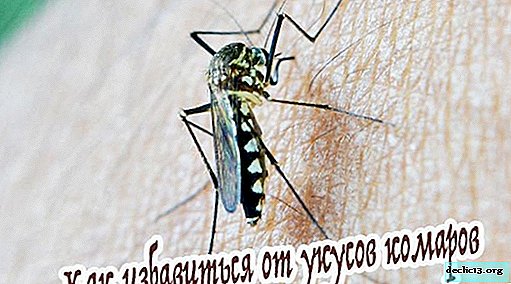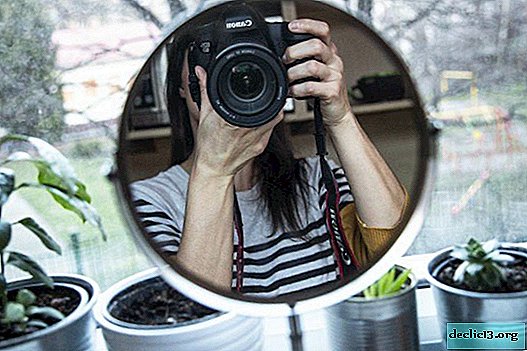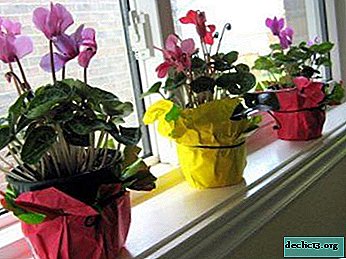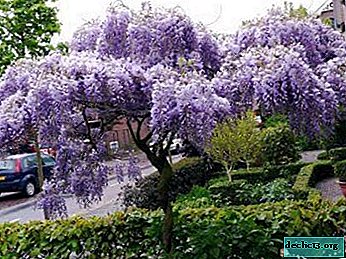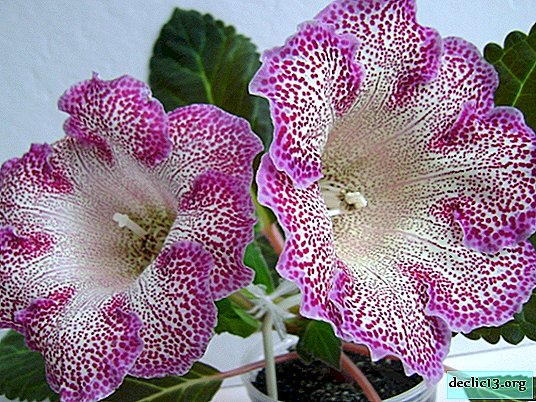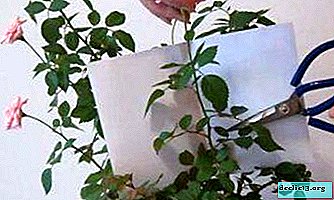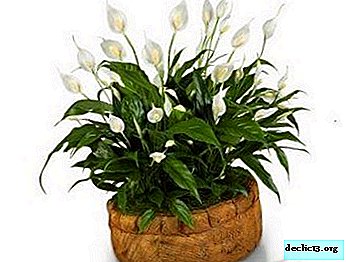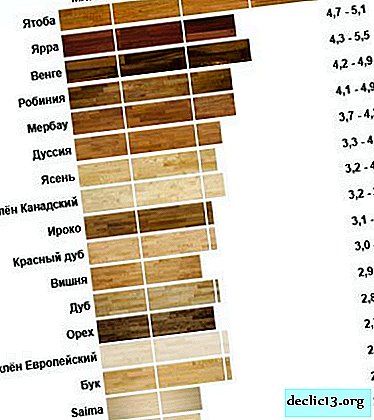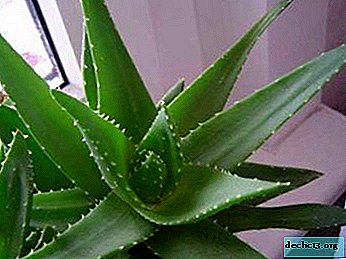The original houseplant or what is the Fox tail and how to care for it?
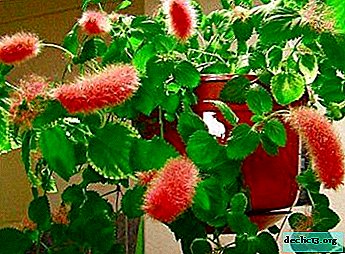 Akalifa (Foxtail) is an original houseplant native to the tropics of Asia.
Akalifa (Foxtail) is an original houseplant native to the tropics of Asia.
Due to the unusual appearance, this flower is actively used by gardeners for landscaping and decorating rooms.
In addition to decorative qualities, Akalifa is famous for its rapid growth and active flowering throughout the year. In addition, its juice is used for the manufacture of homeopathic medicines for the treatment of bronchitis and pneumonia.
So, we will consider in detail how to care for the Foxtail, what problems and difficulties may arise. And also what diseases and pests should be feared.
Plant description
Akalifa translated from Greek means "nettle". This name was given to the flower because of the shape of leaves resembling nettles. Belongs to flowering plants from the family Euphorbiaceae. Wild representatives are found in the tropics of Southeast Asia, South America and Australia, and are lush shrubs up to 3 meters high with bright flower earrings. Because of this unusual shape of the flowers, the plant got its second name - Fox tail.
Indoor akalifa is slightly smaller than a wild relative - only up to 1.5 meters in height. The shape of the leaves is ovoid with a characteristic serrated edge. Small flowers are collected in elongated spike-shaped inflorescences. Indoor varieties are grown with bright pink-red inflorescences and the usual green foliage, or, on the contrary, representatives with nondescript flowers and leaves of various colors.
Attention! Akalifa or fox tail is a poisonous plant.Although the juice of the plant is considered poorly toxic, its ingestion can cause serious consequences. Akalifa should not be in the area of access for children and pets.
Popular views
Among the variety of species of this amazing flower, the following are most often used for growing at home:
- Akalifa oak-leaved (Haitian, Spanish) - grown by ampel method. Shrubs are lush, with a height of not more than 25 cm. Flexible branching shoots of this species are woven into bizarre patterns. The leaves are small, bright green in color. Inflorescences also do not differ in length, but are surprisingly lush, their diameter can be up to 3 cm.
- Akalifa hispida (bristly-haired, fox tail) - The most common room representative of the family. It differs in fur inflorescences up to 50 cm long, dyed, most often, in a bright purple hue. This species can bloom throughout the year, with proper care and compliance with the conditions.
- Akalifa Vilkez - refers to decorative and deciduous indoor plants. Leaves of this species can be of the most diverse shapes and colors. There are varieties whose leaves are twisted or even folded in the shape of a tube; the surface can be decorated with colorful patterns and spots. The size of the leaves can reach 20 cm in length. Flowering is not as spectacular as, for example, with a bristly-haired acalifa, but also quite original - inflorescences in the form of threads or lashes beautifully descend from the leaves of the flower.
- Akalifa State Department - A hybrid species, also characterized by a remarkable green mass. Leaves are rounded oblong, the color is distinguished by a border, highlighting the serrated edge of the leaf. The color of the border is usually of a bronze or golden hue; varieties with white are less common. Particularly noteworthy are specimens that can change to change the green color of leaves red, when exposed to bright light on the foliage.
The description, types and rules for caring for this plant can be found in this article.
Photo
Next, you can see the photo of the flower of akalifa (fox tail) alopecurus pratensis aureovariegatus:



Care
Akalifa is a plant accustomed to a warm, humid tropical climate. For successful growth and development, it is necessary to create this flower as close as possible to the conditions. When caring for Akalifa, the following factors should be considered:
- Temperature mode for this plant is favorable at an indicator of 22 to 25 degrees. Growing in a warm room is especially important for varieties belonging to bristle-hairy, as positive effect on flowering. Even in winter, Akalifa feels great in ordinary room conditions, and does not need a cooler climate. Lowering the temperature to 18 degrees and below can be detrimental to the plant. It is also important to prevent the presence of akalifa in a draft.
- Lighting is an equally important factor for the flower. Akalifa requires bright sunlight at any time of the year. With a lack of sun, the flower stretches, loses its splendor, decorative leaf varieties lose their unusual color. At the same time, direct sunlight, especially in the summer in the afternoon, is no less harmful to the plant. At such a time, it is recommended to remove the flower from the window or shade the plant.
- Soil moisture must be stable, do not allow the soil to dry out. Watering is carried out as the top layer of the earth dries to a depth of 1 cm. It is important to ensure that excess moisture does not accumulate in the pot, in order to avoid root rot. For the same reason, water must not be allowed to accumulate in the pan. Spray the flower should be 1-2 times a day, depending on the humidity in the room. As additional measures of moisture, use special devices or place pallets with wet moss or pebbles near the plant.
- Fertilizers for akalifa are required in a strictly defined quantity. Excess nutrients can be just as harmful as their deficiency. During the period of active growth, from March to September, top dressing is applied once every 2 weeks or twice a month. In winter, the frequency decreases to once a month or completely stops. Fertilizers must contain nitrogen and phosphorus, it is possible to use complex fertilizers in accordance with the type of plant (for flowering or deciduous plants).
- Pruning and pinching necessary to maintain the neat shape of the bush. These procedures are carried out in the spring. Long shoots are removed (later they can be used for cuttings), the tops of the plants are nipped. It is also important to timely remove withered inflorescences, dry and damaged leaves.
Note! It is necessary to carry out pruning and pinching, as well as transplanting the plant with gloves, in order to avoid poisonous juice getting on the skin.
After work, thoroughly wash the instruments and hands with detergent.
Growing problems and difficulties
 The main problem for flower growers growing acalifa is the aging of the plant. Cardinal pruning is carried out for excessively overgrown withering adult plants. All flower shoots are cut so that the remaining branches do not exceed 20-25 cm in length, damaged and diseased branches are cut off at the base. Top shoots can be used for cuttings, provided that they are healthy.
The main problem for flower growers growing acalifa is the aging of the plant. Cardinal pruning is carried out for excessively overgrown withering adult plants. All flower shoots are cut so that the remaining branches do not exceed 20-25 cm in length, damaged and diseased branches are cut off at the base. Top shoots can be used for cuttings, provided that they are healthy.
The trimmed plant is placed under the film so that it gives new shoots faster. It is necessary to maintain humidity and periodically remove the film for ventilation. Yellowed and falling leaves are a signal of excessively dry air. Spraying is required or an air humidifier is required.
Withering of leaves occurs if Akalifa does not receive enough moisture from the soil. The reason for this may be sparse watering or too dense soil. Slowed growth and pale leaves are a sign of a lack of nitrogen in the soil. In this case, it is necessary to increase the amount of nitrogen-containing fertilizing.
Breeding methods
Like many other indoor plants, Akalifa propagated using seeds or cuttings. Planting by cuttings is a simpler method, such sprouts develop faster, unlike seedlings from seeds, so planting cuttings is recommended for beginner growers.
Cuttings
Planting cuttings is carried out in the spring. To do this, use apical tree shoots about 8 cm long, remaining after spring pruning of the mother flowering plant. Decorative deciduous species of the flower are able to give sprouts for cuttings regardless of the season.
The cuttings are planted in wet sand. After that, the sprout is contained at a temperature of +25 degrees and is moisturized abundantly until the roots appear. A month after rooting, pinching the sprout is carried out, removing the upper kidneys. After a couple of weeks, the sprout can be transplanted into a larger pot.
Planting seeds
Sowing of seeds is carried out in early March. The sowing tank is filled with a mixture of sheet soil and sand in equal parts where seeds are sown. The container is covered with a film, after which it is necessary to regularly moisten the future seedlings and maintain the temperature from 20 to 23 degrees. When sprouts with two leaves appear, they are planted at a distance of at least 4 cm from each other or planted in separate containers. When the first kidneys appear, pinching is also carried out.
Diseases and Pests
- Fungus - manifests itself in the form of brown spots on leaves unusual for a healthy plant. To combat this disease, the flower is treated with fungicide.
- Spider mite - an insect feeding on the juice of the leaves of a plant. Due to its small size, it is difficult to notice with the naked eye. Symptoms of the appearance of a tick are yellow spots on the leaves, in neglected cases on the foliage and branches a white web is noticeable. To eliminate the insect, the leaves are treated with tobacco infusion or a solution of an insecticide (Fitoverm, Aktara), prepared in accordance with the instructions.
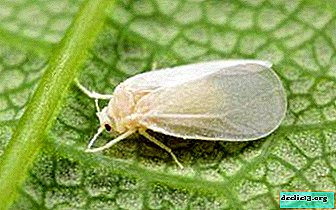 Whitefly - harmful to the plant when laying larvae, which also draw juice from the leaves. Yellowing and wilting of leaves, greenish larvae on the inner side of the leaf indicate the appearance of this insect. To combat, it is necessary to spray with insecticides containing permethrin (Admiral, Kinmix) every three days until the insects completely disappear.
Whitefly - harmful to the plant when laying larvae, which also draw juice from the leaves. Yellowing and wilting of leaves, greenish larvae on the inner side of the leaf indicate the appearance of this insect. To combat, it is necessary to spray with insecticides containing permethrin (Admiral, Kinmix) every three days until the insects completely disappear.- Aphid - numerous small insects, the effect of which leads to twisting and preformation of young leaves, as well as the death of shoots. To get rid of aphids, you must manually remove the pests from the flower, and then treat the acalifa with a special remedy for this insect or an insecticide containing permethrin.
Healing properties
Akalifa is actively used for the manufacture of medical and homeopathic medicines intended for the treatment of bronchitis and pneumonia. Given that the juice of the plant is toxic, it is used only in minimal doses.
Important! Experts do not recommend using acalifa for self-treatment at home.It is also proved that indoor acalifa produces phytonicides, which reduce the number of staphylococci and streptococci in the air, thereby cleaning the room from harmful bacteria.
Useful video
Akalifa or Foxtail. Home Care Tips:
Conclusion
Akalifa is one of the most beautiful and unusual indoor plants. But at the same time, the plant is quite demanding on the conditions of care, for example, it requires high humidity and maintain a warm climate. Also, the flower is poisonous, thereby requiring caution in handling.

 Whitefly - harmful to the plant when laying larvae, which also draw juice from the leaves. Yellowing and wilting of leaves, greenish larvae on the inner side of the leaf indicate the appearance of this insect. To combat, it is necessary to spray with insecticides containing permethrin (Admiral, Kinmix) every three days until the insects completely disappear.
Whitefly - harmful to the plant when laying larvae, which also draw juice from the leaves. Yellowing and wilting of leaves, greenish larvae on the inner side of the leaf indicate the appearance of this insect. To combat, it is necessary to spray with insecticides containing permethrin (Admiral, Kinmix) every three days until the insects completely disappear.
